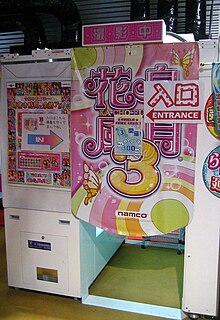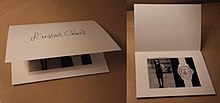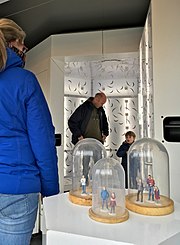Photo booth
This article needs additional citations for verification. (May 2011) |

A photo booth is a vending machine or modern kiosk that contains an automated, usually coin-operated, camera and film processor. Today, the vast majority of photo booths are digital.
History

The patent for the first automated photography machine was filed in 1888 by William Pope and Edward Poole of Baltimore. The first known really working photographic machine was a product of the French inventor T. E. Enjalbert (March 1889). It was shown at the 1889 World's Fair in Paris. The German-born photographer Mathew Steffens from Chicago filed a patent for such a machine in May 1889. These early machines were not reliable enough to be self-sufficient. The first commercially successful automatic photographic apparatus was the "Bosco" from inventor Conrad Bernitt of Hamburg (patented July 16, 1890). All of these early machines produced ferrotypes. The first photographic automate with negative and positive process was invented by Carl Sasse (1896) of Germany.
The modern concept of photo booth with (later) a curtain originated with Anatol Josepho (previously Josephewitz), who had arrived in the U.S. from Russia in 1923.[1] with the first photo booth appearing 1925 on Broadway in New York City. For 25 cents, the booth took, developed and printed 8 photos, a process taking roughly 10 minutes. In the first six months after the booth was erected, it was used by 280,000 people. The Photomaton Company was created to place booths nationwide. On March 27, 1927, Josepho was paid $1 million and guaranteed future royalties for his invention.[2]
Passport photo booths
Most of the photo booths are used for passport photos. They are coin-operated automated machines that are designed to print photo in specific format that meets the passport photo requirements. Multiple copies can be printed so users can save some for future uses.
Traditionally, photo booths contain a seat or bench designed to seat the one or two patrons being photographed. The seat is typically surrounded by a curtain of some sort to allow for some privacy and help avoid outside interference during the photo session. Once the payment is made, the photo booth will take a series of photographs, although most modern booths may only take a single photograph and print out a series of identical pictures.[citation needed] Before each photograph, there will be an indication, such as a light or a buzzer, that will signal the patron to prepare their pose. After the last photograph in the series (typically between 3 and 8) has been taken, the photo booth begins developing the film — a process that used to take several minutes in the old "wet chemistry" booths, but is now typically accomplished in about 30 seconds with digital technology. The prints are then delivered to the customer. Typical dimensions of these prints vary. The classic and most familiar arrangement from the old style photo booths is four pictures on a strip about 40 mm wide by 205 mm long; digital prints tend to have a square arrangement of two images above two images.
Both black and white and colour photo booths are common in the US, however in Europe the colour photo booth has almost entirely replaced black and white booths. However, newer digital booths now offer the customer the option of whether to print in colour or in black and white. Most modern photo booths use video or digital cameras instead of film cameras, and are under computer control. Some booths can also produce stickers, postcards, or other items with the photographs on them, rather or as well as simply a strip of pictures. These often include an option of novelty decorative borders around the photos.
Photo sticker booths
Photo sticker booths or photo sticker machines originated from Japan, are a special type of photo booth that produce photo stickers. Still maintaining huge popularity in Japan, they have spread throughout Asia to Taiwan, South Korea, Hong Kong, Singapore, Malaysia, Philippines, China, Vietnam, and Thailand. They have also been imported to Australia. Some have also begun appearing in the United States and Canada although they failed to make any impression in Europe when introduced in the mid 1990s.[citation needed]

In Japan, purikura (プリクラ) refers to a photo sticker booth or the product of such a photo booth. The name is a shortened form of the registered trademark Purinto Kurabu (プリント倶楽部). The term derives from the English print club. Jointly developed by Atlus and Sega, the first purikura machines were sold in July 1995.[3] The purikura machines were developed in response to young women's interest in both photography and stickers.[4]
Operation
After money has been inserted in the machine, multiple customers can enter the booth and pose for a set number of exposures. Some common options include the ability to alter lighting and backdrops while the newest versions offer features such as cameras from a variety of angles, fans, seats, and blue screen effects. Some establishments even offer costumes and wigs for customers to borrow.
Once the pictures have been taken, the customers select the pictures that they wish to keep and customize them using a touch screen or pen-sensitive screen. The touch screen then displays a vast array of options such as virtual stamps, pictures, clip art, colorful backdrops, borders, and pens that can be superimposed on the photographs.

Features that can be found in some sticker machines are customizing the beauty of the customers such as brightening the pictures, making the eyes sparkle more, changing the hair, bringing a more reddish color to the lips, and fixing any blemishes by having them blurred. Other features include cutting out the original background and replacing it with a different background. Certain backgrounds may be chosen so when the machine prints out the picture, the final sticker will be shiny with sparkles.

Finally, the number and size of the pictures to be printed are chosen, and the pictures print out on a glossy full-color 10 × 15 cm sheet to be cut up and divided among the group of customers. Some photo booths also allow the pictures to be sent to customers' mobile phones. Other photo places have a scanner and laptop at the cashiers desk for customers to scan and copy their original picture before they cut and divide the pictures amongst their group.
Photo booths for parties
Photo booth rental companies allow a person to rent a photo booth for a short period of time (usually in hours) for a fee. Photo booth rentals have become popular in the United States primarily for wedding receptions, sweet sixteen parties, Bar and Bat Mitzvah parties, along with a growing number of other public and private events. In addition to the photo booth and the printing of unlimited photo strips, rental companies usually include a photo booth attendant to service the photo booth and to help guests construct the guest book of photo strips. Online image hosting, compact disks containing the images and related merchandise are readily available. Celebrities are frequent users of photo booths in parties,[5][6]

Apart from traditional photo printing, modern photo booths may also include the following new functions:[7]
- Animated GIF
- Flip book printing
- Virtual props, placed intelligently on the person's eyes or shoulders etc.
- Slow-motion video
- Green-screen background removal
- Fun costume virtual dressing
- Games - mostly Kinect body gesture controlled games, and print a photo of the person and his/her scores
- Facial gesture recognition
Growth of photo booth rentals
As digital cameras, compact photo printers, and flat screen computer monitors became widely available in the early 2000s, people connected these together using a personal computer and software and created their own photo booths. Entrepreneurs began renting machines built along these lines at weddings and parties and the idea spread.[8] From 2005 to 2012, interest in the United States for photo booth rentals grew significantly. By 2016 more people were searching for photo booth rentals than DJ rentals in 15 of North America's largest cities.[9] Photo booth rentals have also become popular in other countries such as Canada, Australia, and the UK.[8] So far in 2016 there is an average of 226,000 monthly searches for a photo booth globally, this has risen by 48.9% since 2015 (In the UK alone this is nearly 20,000 searches a month) [10]
3D Selfie Photo Booths


A 3D selfie photo booth such as the Fantasitron located at Madurodam, the miniature park, generates 3D selfie models from 2D pictures of customers. These selfies are often printed by dedicated 3D printing companies such as Shapeways. These models are also known as 3D portraits, 3D figurines or mini-me figurines.
References
- Massen, Ernst: Kleine Geschichte der Fotoautomaten (Short history of the automatic photo apparatus) – in: Photo Antiquaria 103 (April 2011)
- ^ Goranin, Näkki (March 7, 2008). "The history of the photobooth". The Daily Telegraph.
- ^ "Photo-in-slot Inventor Will Endow Genius", Miami Daily News, March 28, 1927, p15
- ^ Terashita, Naotaka; Kudo, Hiroyuki (1998). “プリクラ”ブームを作った人々 [The people who made a "purikura" boom] (PDF). The Journal of The Institute of Electrical Engineers of Japan (in Japanese). 118 (2): 85–87. doi:10.1541/ieejjournal.118.85.
{{cite journal}}: Unknown parameter|name-list-format=ignored (|name-list-style=suggested) (help) - ^ Miller, Laura. 2003.“Graffiti photos: Expressive art in Japanese girls’ culture.” Harvard Asia Quarterly, Vol. 7 No. 3, pp. 31-42.
- ^ Moon, Rachael (4 November 2015). "The Kardashian beauties posed for the camera at Kendall's 20th birthday party". Retrieved 2 August 2018.
- ^ "Kylie Jenner and Tyga smooch in photo booth at Kris's birthday party". Retrieved 2 August 2018.
- ^ "How Photo Booth Technology Has Improved Over the Years". Tech.co. 2015-10-30. Retrieved 2015-11-25.
- ^ a b "Photo Booth vs Photographer". BestPhotoBooths. Retrieved 2016-05-06.
- ^ "Infographic - Demand for Photo Booths, DJ Services & Wedding Photographers in US & Canada Top Cities". www.forevercaptured.ca. Retrieved 2016-05-06.
- ^ "Infographic - Photo Booth Numbers for 2016". Photobooths. Retrieved 2016-09-21.
Further reading
- Warhol, Andy (1989). Andy Warhol photobooth pictures. New York: Robert Miller Gallery. OCLC 21828769.
- Hines, Babbette (2002). Photobooth. New York: Princeton Architectural Press. ISBN 1-56898-381-6.
- Ratner, Brett (2003). Hilhaven Lodge: the photo booth pictures. New York: PowerHouse Books. ISBN 1-57687-195-9.
- Miller, Laura (2003). "Graffiti photos: Expressive art in Japanese girls' culture". Harvard Asia Quarterly. 7 (3): 31–42. Retrieved 2012-01-07.
- Chalfen, Richard; Murui, Mai (2004). "Chapter 11: Print club photography in Japan: framing social relationships". In Edwards, Elizabeth; Hart, Janice (eds.). Photographs objects histories: on the materiality of images. London and New York: Routledge. pp. 166–185. ISBN 0-415-25441-8.
- Goranin, Näkki (2008). American photobooth. New York: W. W. Norton Co. ISBN 978-0-393-33076-2.
- Woo, Cameron (2010). Photobooth dog. San Francisco: Chronicle Books. ISBN 978-0-8118-7251-5.
- Pellicer, Raynal (2010). Photobooth: the art of the automatic portrait. New York: Abrams. ISBN 978-0-8109-9611-3.
